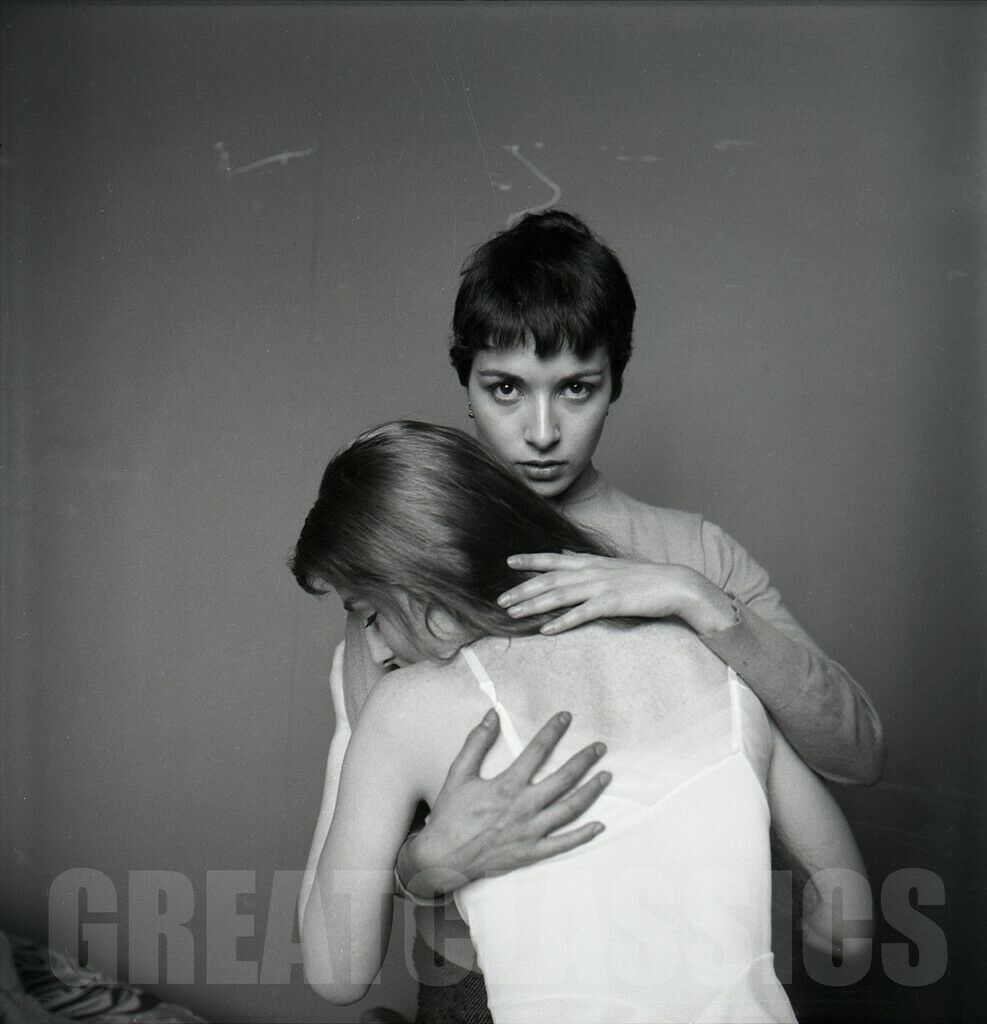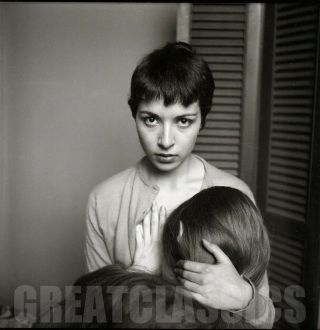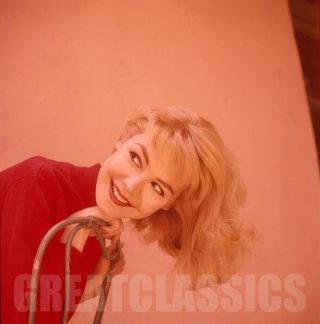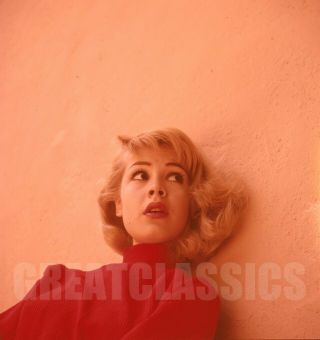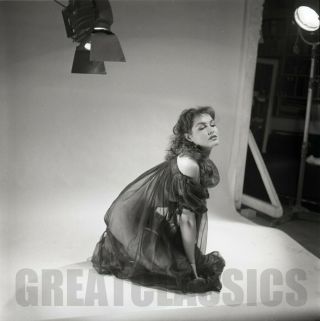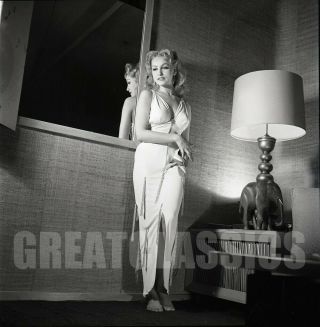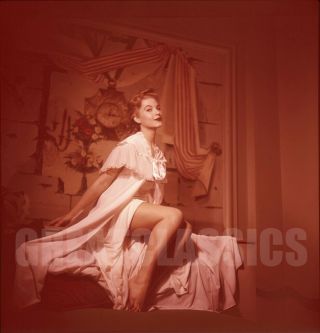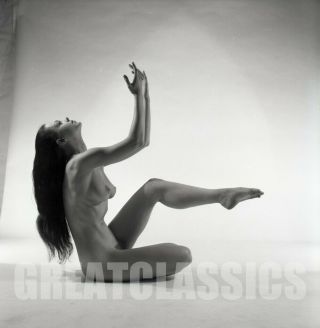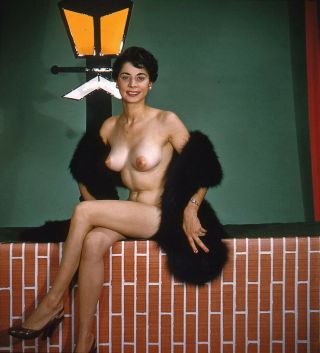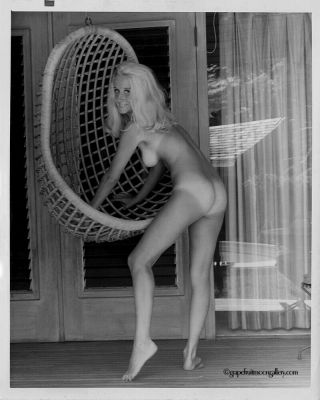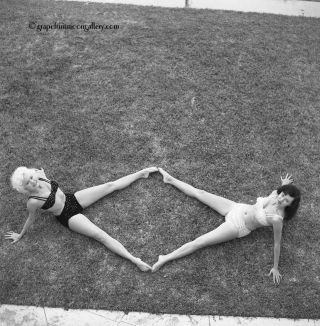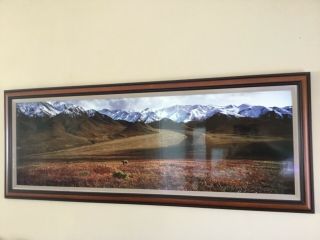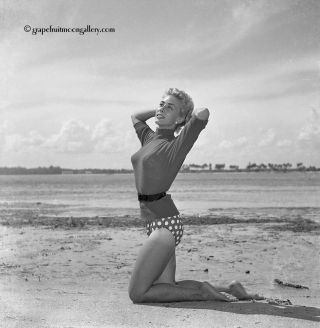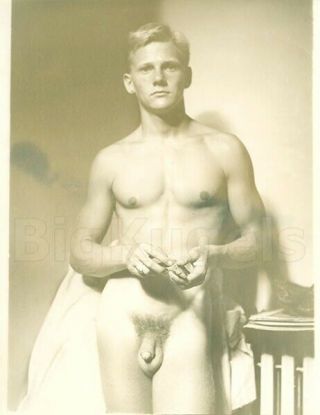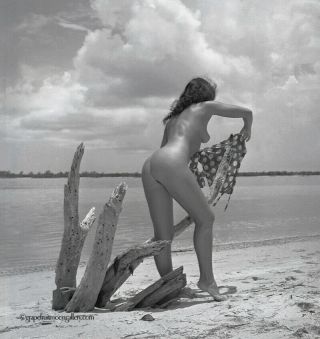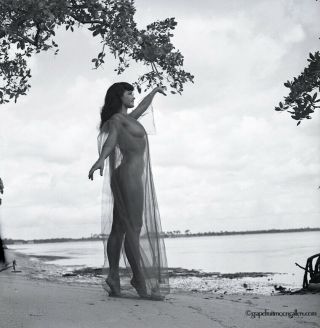EVIL FRIENDSHIP 1958 LESBIAN PULP MODELS 2 1/4 CAMERA NEGATIVE PETER BASCH
Item History & Price
This portrait is from the same shoot but was ultimately not chosen as the final portrait for the published book. Mr. Basch shot several different sessions for use as covers of lesbian paperback novels.
**Please note: the squiggles visible behind the models seem to be on the wall of the apartment the portrait was taken in, and are not flaws of the negative. This is the original negative (film) that was in the camera at the time of the photo shoot and is therefore the only one of its kind in existence. (Please note this listing is for a camera negative, not a photograph. The scan is of its positive view.) (The image of the paperback scan is included as reference only and is not included with the listing. It was found on Pinterest and is copyright by the respective copyright owners.)RIGHTS: The PETER BASCH FAMILY TRUST is the sole and exclusive copyright owner of the listed image(s). No rights are included in this offering. - SIZE: 2 1/4"- TONE: B&W- CONDITION: Fine, with light scuffing, and spotting._______________________________________________________________ CONDITION GRADING Excellent: Very nearly pristine, with no more than trivial flaws. Very Fine: One or two minor defects and only the slightest handling wear. Fine: Minor flaws, with slight handling or surface flaws. Very Good: Slight scuffing, rippling, minor surface impressions. Good: Visibly used with small areas of wear, which may include surface impressions and spotting. Fair: Visibly damaged with extensive wear. SHIPPING TERMS - I ship all items using, what I call, triple protection packing. The photos are inserted into a display bag with a white board, then packed in between thick packaging boards and lastly wrapped with plastic film for weather protection before being placed into the shipping envelope. - The shipping cost for U.S. shipments includes USPS "Delivery Confirmation" tracking. - I am happy to combine multiple wins at no additional cost. Please wait for me to issue the invoice before making payment. PAYMENT TERMS - Please pay within three (3) days of purchase. - I reserve the right to re-list the item(s) if payment is not received within seven (7) days. - California residents - please wait for me to adjust the invoice to include California Sales Tax of 7.5% and 9% for Los Angeles residents. CUSTOMER SERVICE - I will respond to all inquiries within 24 hours. ________________________________________________________________ PETER BASCH (1921-2004) was a German/American glamour photographer who captured thousands of images of the most prominent stars of the 50s and 60s. Peter Basch was born in Berlin, Germany, the only child of Felix Basch and Grete Basch-Freund, both prominent theater and film personalities of the German-speaking world. In 1933 the family came to New York due to fears of rising anti-Jewish sentiment and laws in Germany. The family had US citizenship because Felix's father, Arthur Basch, was a wine trader who lived in San Francisco. After moving back to Germany, Arthur Basch kept his American citizenship, and passed it to his children and, thence, to his grandchildren. When the Basch family arrived in New York in 1933, they opened a restaurant on Central Park South in the Navarro Hotel. The restaurant, Gretel's Viennese, became a hangout for the Austrian expatriate community. Peter Basch had his first job there as a waiter. While in New York, Basch attended the De Witt Clinton High School. The family moved to Los Angeles to assist in Basch's father's career, during which time Basch went to school in England. Upon returning to the United States, Basch joined the Army. He was mobilized in the US Army Air Forces' First Motion Picture Unit, where he worked as a script boy. After the war, he started attending UCLA and started taking photographs of young starlets working with other photographers and film studios. His mother asked him to join her back in New York after she and his father decided that Basch should be a photographer and they obtained a photography studio for their son. For over twenty years, Peter Basch had a successful career as a magazine photographer. He was known for his images of celebrities, artists, dancers, actors, starlets, and glamour-girls in America and Europe. His photos appeared in many major magazines such as Life, Look and Playboy.The Peter Basch Collection includes iconic images of all the major midcentury stars, from Europe and America. These masterful images are a window onto a time we cannot forget, when movie stars stepped out of the studio’s control, and we began to see these larger-than-life performers as full, three-dimensional personalities. Basch’s images capture the heart and spirit of these glamorous performers. Taking pictures in natural light, out in the world, we see these stars as full human beings, not the carefully made-up, studio-approved icons of oldfashioned Hollywood. Basch was able to capture the moments of a human being’s spirit, their mercurial reactions, all the facets that made these magnetic individuals the stars they were. Basch authored and co-authored a number of books containing his photographs including: Candid Photography (1958 with Peter Gowland Basch and Don Ornitz Basch) Peter Basch's Glamour Photography (A Fawcett How-To Book) (1958) Peter Basch photographs beauties of the world (1958) Camera in Rome (1963 with Nathan and Simon Basch) Peter Basch Photographs 100 Famous Beauties (1965) The nude as form & figure (1966) Put a Girl in Your Pocket: The Artful Camera of Peter Basch (1969) Peter Basch's Guide to Figure Photography (1975 with Jack Rey) Thoughts on Peter Basch by his daughter: "My Father, Peter Basch, saw. He looked and he saw. He taught me to see. He taught me to listen and hear. We used to play a game when I was little. He’d say, Michele, look at the street then look at me, what did you see? I would list the cars, red, black, navy; people, fat, tall, thin; children, parents; trees and plants. He would add the detail. A blue car with New York plates, a black car with New Jersey plates. The people were not just tall or small, thin or fat, they wore coats or sweaters, they laughed or were sad. The trees had leaves, were close together, the green was dark, vivid, the sun playing with the shadow. My Father saw. He captured in his mind and on film the unexpected moment in time, the interaction between two people, the look, the thought, the breath that punctuated the decision. My Father was one of the great romantics. He had a true love and appreciation of beauty in its purest form. We would talk about BEAUTY and her differences: natural, Hollywood, young, old and the beauty of communication, interaction, the Beauty of the moment. He recorded the breath in time on film: two ladies in Paris reading the paper, a Dachshund looking around the corner, a chair in front of the Eiffel Tower. My Father saw the thought and seized it for posterity. My Father understood the language light speaks to shadow. He showed me how the sun plays with dark. His favorite moment was at Sunrise when the shadows were long and soft. He saw every hue from white to black and everything in between. He understood the language, taught and published books on Light and Shadow, Form and Figure. I traveled through Europe with my Father. I was his assistant! And proud of it! I was the camera person! Changed the film, made sure the lens was clean, stood in during special poses, helped in the dark room, retouched to refine and perfect. I loved watching him talk and listen. He listened to Jane Fonda, Ursula Andress, Brigit Bardot, Fellini, Mastroiani and so many more. He listened and recorded the answer, the thought, that moment of indecision, realization and Seduction." Film Assignments: 8½ - Fellini Jules et Jim - Truffaut Bijoutiers du Clair de Lune - Vadim The Vice and the Virtue - Vadim Fearless Vampire Killers - Polanski Yesterday, Today and Tomorrow - De Sica Une Femme Est Une Femme Goddard Fear - Rosselini Cartouche - De Broca Giant - Stevens Anne Frank - Stevens Guys and Dolls - Mankiewicz Horse Soldiers - Ford Majority of One - Leroy Walk on the Wild Side - Dmytryk Wild in the Streets - Spear Leonidas - Matte The Day the Fish Came Out - Cocayannis The Pawnbroker - Lumet La Verite - Clouzot La Loi Sacree - Pabst Baby Doll - Kazan Summertime - Lean The 13 Most Beautiful Girls - Warhol The Three Sisters - Bogart Francis of Assissi - Curtiz The Swimmer Perry Cape Fear The Man Who Had Power Over Women The Spy With The Cold Nose Winnetou Mata Hari Exhibitions: 2002 Jewish Museum - Vienna Austria “Vom Grossvater vertrieben” 2002 LEICA Gallery, NYC Portrait of Al Hirschfeld 2001 National Portrait Gallery -- London Dame Elizabeth (Taylor) 2001 Fahey-Klein Gallery, LA Group Show/Great Directors 2001 Museum/City of New York, Al Hirschfeld Exhibit 2000 Museum of Modern Art, NY, Brigitte Bardot 1999 Vienna, Austria – “übersee” 1999 Stadt Museum, Munich, Germany “TWEN” exhibit 1997 Museum of the Moving Image – Grace Kelly 1996 Staley Wise Gallery, NY “Shooting Stars” – one man show 1980s Museum of Modern Art, NY, Sophia Loren LA County Museum "Masters of Starlight" (subsequently traveled to Tokyo & Kyoto, Japan) Stadt Museum, Munich, Germany “AKT” (nudes) __________________________________________________________________LESBIAN PULP FICTION Lesbian pulp fiction refers to any mid-20th century paperback novel (often conflated with pulp magazine fiction) with overtly lesbian themes and content. Lesbian pulp fiction was published in the 1950s and 60s by many of the same paperback publishing houses that other genres of fiction including Westerns, Romances, and Detective Fiction. Because very little other literature was available for and about lesbians at this time, quite often these books were the only reference people (lesbian and otherwise) had for modeling what lesbians were. Stephanie Foote, from the University of Illinois commented on the importance of lesbian pulp novels to the lesbian identity prior to feminism: "Pulps have been understood as signs of a secret history of readers, and they have been valued because they have been read. The more they are read, the more they are valued, and the more they are read, the closer the relationship between the very act of circulation and reading and the construction of a lesbian community becomes...Characters use the reading of novels as a way to understand that they are not alone."Writer Donna Allegra explained why she purchased them in saying, "No matter how embarrassed and ashamed I felt when I went to the cash register to buy these books, it was absolutely necessary for me to have them. I needed them the way I needed food and shelter for survival."Pulp or paperback fiction novels have been tagged as such because of their similarity in packaging (and sometimes in content) to the fiction magazines printed on the cheap wood pulp paper they were printed on. These books were sold at drugstores, magazine stands, bus terminals and other places where one might look to purchase cheap, consumable entertainment. The books were small enough to fit in a purse or back pocket (hence both the brand-name and the generalized term "pocket books") and cheap enough to throw away when the reader was through with it.In the early to mid 20th century, only a handful of books were published that addressed lesbians as characters in relationships with women. Those notable novels were published in hardback and were as follows:• We Too Are DriftingIn 1935, Gale Wilhelm published We Too Are Drifting with Random House. A tale of drama and damnation, loathing and loss, We Too Are Drifting explored woodcut artist Jan Morales' life as she falls out of love with a first female lover and into a tortured situation with another woman, whom she loses in the end. Not a happy ending, which was apparently a result that lesbian readers expected.• Pity for WomenDoubleday brought out Helen Anderson's Pity For Women in 1937. The two characters, Ann and Judith, are filled with less loathing than Wilhelm's women in We Too Are Drifting, but drama and loss still reign supreme. Lesbian literary historian Linnea Stenson says that Pity For Women is the first lesbian novel to show evidence of a resistance by the author - and characters - to the prevailing attitudes of prejudice and misunderstanding. In these modern days of so much political and social discussion of gay and lesbian marriage, it's interesting to note that Ann and Judith pledge themselves to one another using the words that Ruth spoke to Naomi in the Bible. ("Whither thou goest, so shall I….) This is the first instance of two women in lesbian literature attempting to formalize their union with one another. But it's not enough to save Judith and Ann. The women are separated at the end with one of them insane and again, no happy ending.• Torchlight To Valhalla (later titled The Strange Path when reissued in paper in 1953)Gale Wilhelm's Torchlight To Valhalla (1938) marked the first subtle shift away from the tortured souls in the few previous novels containing lesbian themes. It might, in fact, be considered the first overt lesbian coming out novel. Young writer Morgen struggles with her identity as well as with the attention of a young male suitor only to finally accept that she loves Toni, a seventeen-year-old girl four years her junior. For the first time in a lesbian novel, both characters were given androgynous names, Morgen and Toni. Though Patricia Highsmith's 1952 novel The Price of Salt (written under the pen name Claire Morgan) is generally given credit as the first novel in which the two heroines experience a positive ending, the 1938 Torchlight predates it.After World War II, there appeared a new and often subversive trend in publishing that allowed for books to be written, cheaply produced, and widely distributed using technology previously unavailable. These books were dubbed "pulp" fiction because they were inexpensive and usually sensational or low-brow, much like the "pulp" magazines of the first half of the 20th century. These mass market paperbacks, printed and bound on cheap paper, often addressed "dirty" topics like drugs, gangs, white slavery, crime, murder, and homosexuality. Because the literature was not respected, it was not censored as readily, although most of the larger paperback publishers were wary of postal censorship, and, for instance, took care not to publish works that were overly supportive of "deviant" lifestyles. In terms of lesbian fiction, these books were the only ones available in many locations to people who had no previous access to information or stories that involved lesbian characters.Hundreds of titles were published in this genre from 1950–1969, and millions of copies of each title were often were sold. This was part of no social agenda on the publishers' parts: they were making quite a bit of money. However prevalent the books were, purchasing and reading them for many women was the equivalent to coming out to the cashier. Author Joan Nestle called them "survival books" and described purchasing them:The act of taking one of these books off the drugstore rack and paying for it at the counter was a frightening and difficult move for most women. This was especially true during the atmosphere of the McCarthy trials...Although tame by today's standards...these volumes were so threatening then that women hid them, burnt them, and threw them out."The first paperback to address a lesbian relationship was published as early as 1950 with Women's Barracks by Tereska Torres, published by Gold Medal Books. The story was fictionalized account of Torres' experiences in the Free French Forces in London during World War II. Women's Barracks sold 4 million copies and was selected in 1952 to become an example of how paperback books were promoting moral degeneracy, by the House Select Committee on Current Pornographic Materials.Accounting for the success of Women's Barracks, it is not a coincidence that Gold Medal Books published another paperback with lesbian themes, and in fact, eventually published some of the least homophobic books in the genre.Spring Fire by Marijane Meaker writing as Vin Packer is generally considered to be the first lesbian paperback novel, since the plot focused on the relationship of the two main characters, as opposed to the various relationships examined in Women's Barracks. It is also the first modern lesbian novel written by a lesbian. Spring Fire, which was published by Gold Medal Books in 1952 and sold more than 1.5 million copies, is about two college girls, Mitch and Leda, who fall in love and have an affair. The tragic endings of Women's Barracks and Spring Fire (suicide and insanity) are typical of lesbian pulp novels. Meaker was told by her editor that because the books traveled through the mail and anything sent through the U.S. Postal Service was subject to government censorship, publishers had to make sure that the books seemed in no way to proselytize homosexuality.[10] No character was allowed to be both homosexual and happy at the book's end. A character had either to turn straight and end up coupled with a man or, if she remained homosexual, suffer death, insanity or some equally unappealing fate. Although originally published in hardback and technically not a pulp novel (it however quickly became available in paperback form), the first exception to this formula is the book The Price of Salt written by Patricia Highsmith under the pen name Claire Morgan. Throughout the genre, satisfactory endings for women who accepted their homosexuality were rare.Odd Girl and The Third Sex by Artemis Smith, a pen name for philosopher and early 1950s gay/feminist activist Annselm Morpurgo, were finally published by Beacon Books in 1959 after multiple rejections by major publishers. Unlike former pulp novels, these also contained strong political statements that influenced the formation of the gay rights movements of the late 1950s. Originally titled Anne Loves Beth, Odd Girl was extensively blue-penciled by the pulp editors. The original version has recently been reissued by the Author through 'the savant garde workshop', a service press for The Savant Garde Institute. In her 1960's addresses to East Coast Homophile Organizations meetings in Philadelphia, Artemis Smith originated the "come out of the closet" slogan and strategy for linking the gay rights movement to other rights movements in which, as both novelist and playwright, she was also a spokeswoman.Content and quality of the books varied widely. Authors of lesbian paperbacks were both male and female, and often used pseudonyms - the male authors frequently used female names. One retrospective summed up the genre as, "The vast majority of these lesbian novels were written by men, designed to fulfill straight men's fantasies...But perhaps 40 or 50 lesbian (pulp) novels were written by women, and were also good enough to becoming underground classics...The pulps also reached isolated, small-town lesbians who could read them and see that they were not the only lesbians in the world."Writer Yvonne Keller divides books within the lesbian pulp fiction genre into subclasses she labels "pro-lesbian" and "virile adventures". Pro-lesbian paperbacks were generally about and by women, featured a love story between women, had fairly well-developed characters, and tended not to feature gratuitous or graphic sexual encounters. Virile adventures were more male centered, perhaps with at least one male main character, and featured graphic depictions of sex. Author Paula Christian described her inspiration to write during this period: "Contemporary fiction showed such instability, violence, and sensationalism...I simply wanted to show the other side."However, the majority of books in the lesbian paperback fiction genre promoted myths about lesbians and lesbianism. Women who are left without men can be seduced and violated by predatory lesbians (usually butch women). The depictions of lesbianism in prison, the military, and boarding schools was a well-used motif. Lesbianism was often linked to other topics that were seen as salacious or shocking at the time: witchcraft, Satanism, bondage and discipline, orgies, and voyeurism.Barbara Grier, who started Naiad Press called the years between 1955 - 1965 the Golden Age of Lesbian Pulp Fiction. Grier republished many of the books in this span in the 1980s under Naiad, and Cleis Press and Feminist Press have again reissued them. Several writers of this "Golden Age" stood out for their contributions to gay and lesbian literature and their formation of a lesbian identity prior to the advent of feminism:Ann Bannon (Ann Weldy b. 1932) wrote six lesbian themed pulp novels from 1957 to 1962 that later became known as The Beebo Brinker Chronicles. The popularity of the books as well as the continuity of characters gave them a remarkable longevity and earned her the title, "Queen of Lesbian Pulp Fiction." Her books were re-released in 1983 and again in 2001.Bannon wrote: Odd Girl Out, 1957 Gold Medal Books; I Am a Woman, 1959 Gold Medal Books; Women in the Shadows, 1959 Gold Medal Books; Journey to a Woman, 1960 Gold Medal Books; The Marriage, 1960 Gold Medal Books; Beebo Brinker, 1962 Gold Medal BooksValerie Taylor (Velma Nacella Young 1913–1997) wrote eight lesbian themed novels from 1957–1964, poetry that was published in The Ladder, and several novels in the 1970s through Naiad Press. She became a gay activist, co-founding the Mattachine Society and the Lesbian Writers' Conference in Chicago in 1974.Taylor wrote: Whisper Their Love, 1957 Gold Medal Books; The Girls in 3-B, 1959 Gold Medal Books; Stranger on Lesbos, 1960 Gold Medal Books; A World Without Men, 1963 Midwood-Tower; Unlike Others, 1963 Midwood-Tower; Journey to Fulfillment, 1964 Midwood-TowerMarijane Meaker (born 1927) wrote under the pen names of Vin Packer and Ann Aldrich, as well as serving as a copy-editor for Gold Medal Books. Packer's books were generally mystery novels, but using her Ann Aldrich name she wrote nonfiction books about lesbians that were not overly sympathetic about lesbianism and earned Meaker the ire of the Daughters of Bilitis printed in The Ladder. Barbara Grier once referred to her as "the evil genius." Meaker later wrote books for young adults under the names M.E. Kerr and Mary James.Meaker wrote: Spring Fire, 1952 Gold Medal Books; We Walk Alone, 1955 Gold Medal Books; We Too Must Love, 1958 Gold Medal Books; Carol in a Thousand Cities, 1960 Gold Medal Books; We Two Won't Last, 1963 Gold Medal Books; Take a Lesbian to Lunch, 1972Lee Lynch (author) (born 1945) has written sixteen lesbian-themed works since 1983. In the mid-1960's until its demise, she published regularly in The Ladder, and has written a syndicated column since 1986 called The Amazon Trail. Known for being the first novelist to address butch and femme issues in her fiction, Lynch has continued to write essays, articles, short stories, and novels.Her novels include: Toothpick House, The Swashbuckler, Dusty's Queen of Hearts Diner, Sue Slate, Private Eye, The Old Studebaker, Morton River Valley, Rafferty Street, Sweet Creek, Beggar of Love, and The Raid.Marion Zimmer Bradley (1930–1999) wrote under various pen names, eventually becoming quite popular for her Avalon and Darkover series. For years Bradley refused to admit she authored her early paperback lesbian fiction, and was reluctant to publicly speak about her work on The Ladder.Bradley wrote: I am a Lesbian, 1962 as Lee Chapman; No Adam for Eve, 1966 as John Dexter; My Sister, My Love, 1963 as Miriam Gardner; Twilight Lovers, 1964 as Miriam Gardner; The Strange Women, 1967 as Miriam Gardner; Spare Her Heaven, 1963 as Morgan Ives; Anything Goes, 1964 as Morgan Ives; Knives of Desire, 1966 as Morgan IvesLesbian pulp novels typically had lurid, titillating cover art. Although many women (lesbian and otherwise) bought and read these novels, book publishers marketed them to men as erotic fantasy. Covers might have a few provocative lines of text meant to draw attention to the sexy and scandalous nature of what was between the covers. Publishers inserted words such as "twilight", "odd", "strange", "shadows" and "queer" in the titles of these books. "Author Ann Bannon has stated that men would read the covers literally, attracted to the art of half-dressed women in a bedroom scene, and women would read the covers iconically: two women looking at each other, or one woman standing, another on a bed, with the trigger words of "strange" or "twilight" meant that the book had lesbian content in it.In 1964, Desert of the Heart by Jane Rule and Mrs. Stevens Hears the Mermaids Singing by May Sarton in 1965 were published by mainstream publishers in hardback, both enjoying a fairly successful run. Patience and Sarah (originally self-published by author Alma Routsong in 1969) is considered the first novel to initiate a feminist publishing run. In 1973, Naiad Press was founded by Barbara Grier, which concentrated mainly on lesbian-themed books. The growth of the pornographic industry after a series of United States Supreme Court decisions disallowing the censorship of pornographic material was evident in books that served to be more graphic in nature than focusing on the relationships of the women in the stories, which also led to the decline of lesbian pulp fiction. Authors March Hastings and Paula Christian both stated their publishers lost interest in their subject in the mid 1960s. As well, common plot points in the books involved women who were coming to terms with realizing their attraction to women in a world that did not allow it. With the rise of feminism, and the gay rights movement in 1969, these plot points were decreasingly relevant.In much the same way as publication of the 1950s/1960s pulp novels was made possible by new technology, another wave of lesbian literature came into existence due to the new technologies of the 1980s to the present. In the 1980s and 1990s, lesbian fan fiction surged to the forefront with hundreds of authors writing stories, novels, and whole series and making them available online via the Internet. This online publication continues to be popular to this day. Many of those authors gravitated away from fan fiction and began to write original works, and small presses sprang up to publish that work. With the proliferation of offset printing and the subsequent widespread availability of print on demand technology and desktop publishing, for the first time in history, small presses with little capital began to regularly publish lesbian voices. By the turn of the 21st Century, over a dozen lesbian fiction and nonfiction publishers had emerged, and they are successfully marketing hundreds of new titles yearly for the lesbian audience. The three largest publishers going into this new millennium are Bella Books, Bold Strokes Books, and Regal Crest Enterprises.The latest technological innovation, electronic E-books, has made it possible for out-of-print books to be made available for the reading public to enjoy. Many of the old pulp novels have been reissued in e-book form, and most print books published today are also issued as e-books. Courtesy of Wikipedia



